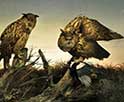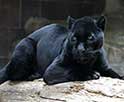Dire Wolf (Aenocyon dirus): characteristics, habitat, reproduction, diet, and extinction
Dire Wolf (Aenocyon dirus): Facts, Habitat, and Extinction
Reading time : 1 minute,
Discovery Chepe Id-665-ECO
Published in
04-12-2025

The dire wolf, scientifically known as Aenocyon dirus and often referred to as the giant wolf, was one of the most remarkable predators of the Pleistocene megafauna. Though made famous by its fictional portrayal in pop culture, particularly in the series *Game of Thrones*, this animal was a real and powerful hunter that once roamed North America.
Characteristics of the dire wolf
Size: Aenocyon dirus was larger and more robust than the modern gray wolf. It measured between 1.5 and 1.8 meters in length and weighed between 60 and 90 kg, with some individuals exceeding 100 kg.
Bite strength: It had an extremely strong bite, capable of crushing large bones, allowing it to scavenge as well as hunt.
Build: It had a broad skull, large teeth, and a muscular body, well-adapted for taking down large prey.
Habitat of the dire wolf
Geographic range: This predator inhabited much of North America, from Canada down to northern Central America.
Preferred environments: It favored open plains, temperate forests, and regions rich in large herbivores.
Fossil records: Some of the best-preserved fossils have been found in the La Brea Tar Pits in California.

The Extinction of the Dire Wolf: What Happened?
Reproduction
Pack behavior: It is believed that dire wolves lived in organized packs with social hierarchies similar to modern wolves.
Alpha reproduction: The alpha pair were the primary breeders, and pups were cared for by the entire pack.
Evolutionary advantage: This social structure provided hunting efficiency and protection for the young.
Diet
Main prey: Their diet included large mammals such as bison, wild horses, prehistoric camels, giant ground sloths, and occasionally mammoths.
Scavenging: They also scavenged carcasses, using their powerful jaws to break bones and access marrow.

In an illustration by paleoartist and researcher Mauricio Antón, we see a group of dire wolves competing with a pack of gray wolves for the carcass of an American bison in what is now North America.
Extinction of the dire wolf
Time of extinction: They disappeared around 10,000 years ago, at the end of the Pleistocene epoch.
Climate change: The shift to the Holocene brought environmental changes that reduced prey availability.
Competition: They faced increased competition from gray wolves and early human hunters.
Genetic isolation: Recent DNA studies show that dire wolves were genetically distant from gray wolves, limiting their adaptability.
Did you know??
Despite their name, Aenocyon dirus was so genetically distinct from modern wolves that they belong to a separate genus: Aenocyon, meaning terrible dog.
This majestic predator remains one of the most iconic examples of Ice Age wildlife, and its legacy continues to captivate scientists, nature enthusiasts, and paleontology lovers worldwide.
See Also
Discovery Chepe
Most read...















